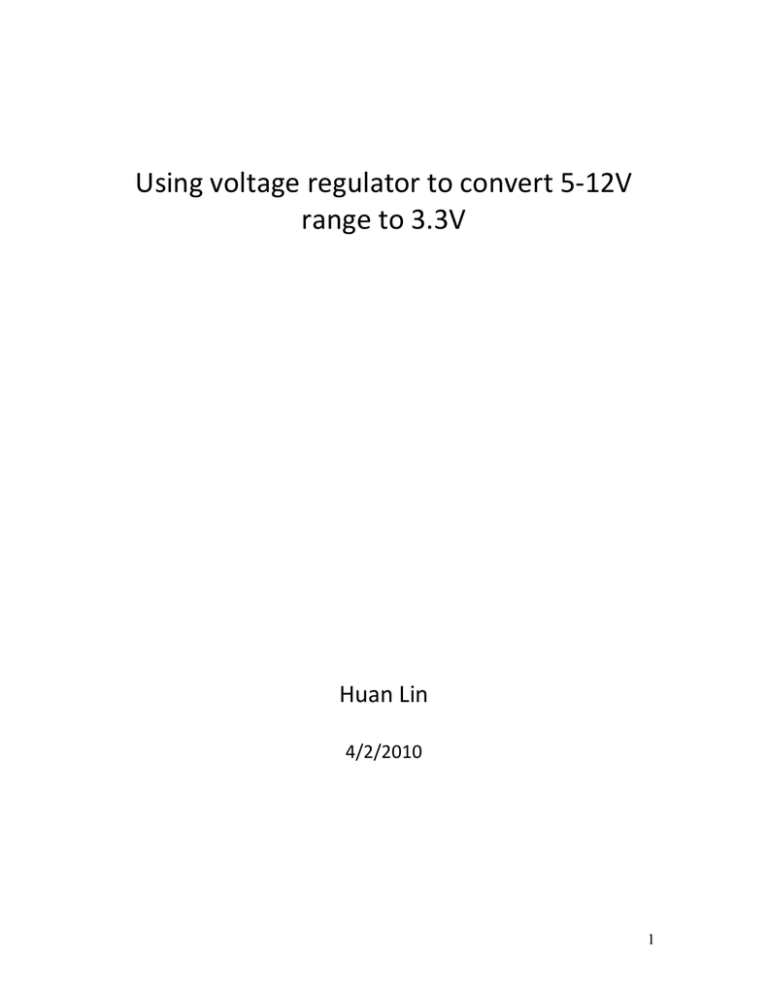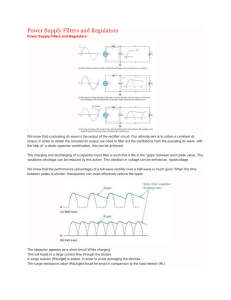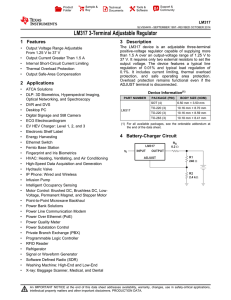Using voltage regulator to convert 5
advertisement

Using voltage regulator to convert 5-12V range to 3.3V Huan Lin 4/2/2010 1 Table of Contents 1. Introduction ................................................ Error! Bookmark not defined. 2. Objective ..................................................... Error! Bookmark not defined. 3. Implementation ......................................... Error! Bookmark not defined. 4. Recommendation..................................................................................... 8 5. References ............................................................................................... 8 2 Executive Summary: There are variety ways of building 3.3V power supply, such as using voltage divider, voltage regulator and DC-DC convertor. This application note will discuss how to build a 3.3V power supply circuit using different voltage regulators. A voltage regulator is an electrical regulator designed to automatically maintain a constant voltage level. Depending on the design, it may be used to regulate one or more AC or DC voltages. Keywords: LM1117, LM117/LM317A/LM317, LM3940, MSP430 Introduction: There are variety voltages regulators that can be selected to build a 3.3V power supply circuit. Generally, there are two types of regulator, linear regulators and switching regulators. Linear regulators are based on devices that operate in their linear region, versus, switching regulators are based on a device forced to act as an on/off switch. Using adjustable regulator such as LM117 gives the advantage of outputting two selectable regulated voltages. For a circuit which needs stable 3.3V power supply, it is not necessary to choose adjustable regulator. Instead using Low-Dropout Linear Regulator such as LM1117 and LM3940 is good enough to output stable 3.3V. At the end, how to choose the right regulator depends on the connected load current. Objective: This application note will introduce three possible voltage regulators for 5-12V range to 3.3V conversion and how to build the circuit. Finally, it will present the 3.3V circuit design for the SAiNT project. Implementations: LM117/LM317A/LM317 General Description: The LM117 series of adjustable 3-terminal positive voltage regulators can supply in excess of 1.5A over a 1.2V to 37V output range. The connection Diagram of the chip is shown in Figure1. For a non-standard voltage, LM317 voltage regulator is very useful. The circuit is shown in Figure 2. 3 Operating Temperature Range LM117 -55 °C ≤ Tj ≤ +150 °C LM317A -40 °C ≤ Tj ≤ +125 °C LM317 0 °C ≤ Tj ≤ +125 °C Connection Diagram: Figure 1 Typical Application: Figure 2 The output voltage is selected using two resistors. Normally R1 is chosen to be around 220Ω or 240Ω. The formula for calculating the value of R2 is 4 V=1.25 (1+ (R2/R1)) Or to put it another way R2=R1((V/1.25)-1) Setting R2 to zero (ground the adjusting pin) will cause the output voltage to drop to 1.25V. R2 may be replaced by a pot to give an adjustable output voltage range. Sample Schematic of 3.3V using LM317 Figure3 This circuit can take power from a DC wall wart of 5-10V and outputs a selectable 5V or 3.3V regulated voltage. LM3940 General Description: The LM3940 is a 1A low dropout regulator designed to provide 3.3V from a 5V supply. It is ideally suited for systems which contain both 5V and 3.3V logic, with prime power provided from 5V bus. Because the LM3940 is a true low dropout regulator, it can hold its 3.3V output in regulation with input voltages as low as 4.5V. Applications Laptop/Desktop Computers and Logic Systems 5 Connection Diagram Figure4 Typical Application Figure 5 Vin = 5V Vout = 3.3V Iout = 1A LM1117 General Description: The LM1117 is a series of low dropout voltage regulator with a dropout of 1.2V at 800mA of load current. It is available in five fixed voltages, 1.8V, 2.5V, 2.85V, 3.3V and 5V. It is also available in an adjustable version, which can set the output voltage from 1.25V to 13.8V with only two external resistors. This application note only demonstrates the sample circuit with 3.3V fixed voltage. 6 Applications: Battery Charger, Battery Powered Instrumentation and Post Regulator for Switching DC/DC Converter Operating Temperature Range LM1117 0 °C to 125 °C LM1117I -40 °C to 125 °C Connection Diagram Figure 6 Typical Application Figure7 7 Design circuit of 3.3V using LM1117 ( Power supply circuit used in SAiNT Project) Figure8 This circuit can take power from a DC wall charger of 5-12V and outputs a 3.3V regulated voltage and output current 800mA. Recommendation: For SAiNT Project, LM1117 is selected. The designed schematic is shown in Figure 8. After building it on the breadboard, the circuit satisfied outputting 3.3V and 700mA, which is sufficient to supply power for MSP430. There are several reasons for choosing LM1117 for this project. First of all, the load voltage is a fixed 3.3V. Therefore, there is no need to use an adjustable regulator, LM317. Second of all, comparing two Lowdropout Linear Regulator’s load current, LM1117 output lower current than LM3940. So far the load current is estimated to be below 1A. LM1117 outputs 800mA current versus LM3940 outputs 1A current. Therefore, the LM1117 was selected. Reference: "LM117/LM317A/Lm317 3-Terminal Adjustable Regulator". National Semiconductor. May 1996< http://www.national.com/ds/LM/LM117.pdf> "LM1117/LM1117I 800mA Low-Dropout Linear Regulator". National Semiconductor. April 2006< http://www.national.com/ds/LM/LM1117.pdf> "LM3940 1A Low Dropout Regulator for 5V to 3.3V Conversion". National Semiconductor. April 2006< http://www.national.com/ds/LM/LM3940.pdf> "Breadboard Power Supply 5V/3.3V". SparkFun Electronics. 10-8-05 < http://www.sparkfun.com/datasheets/Prototyping/Breadboard-PowerSupply-v2.pdf>. 8 9




